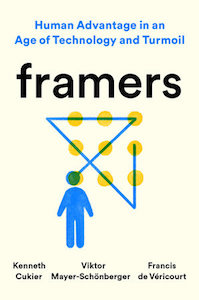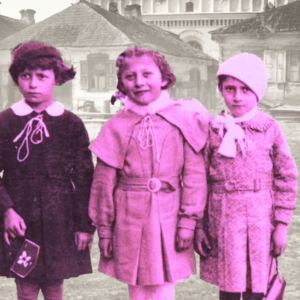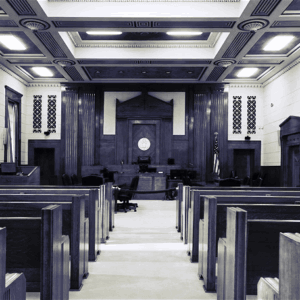
On the Evolutionary Uses of Storytelling
How Counterfactual Realities Make Us Better Thinkers
Image by Benjamin F. Berlin, via LACMA
Mental Rehearsals
Imagining alternate realities does not stop with childhood. We practice our ability to construct counterfactual realities throughout our lives. Consider literature and art. We are transfixed by stories of daring feats, dangerous threats, and desperate ordeals. They can be long or short, comic or tragic, extraordinary or artfully banal. But we love telling stories and listening to them.
Stories are evolutionarily useful because they help us hone our reasoning with counterfactuals. They are springboards to thinking vividly and imaginatively. Epic adventures are a feature of many cultures and eras, from the stories that comprise the holy texts of religious traditions to the Harry Potter series that delights Muggles everywhere. Salt and sugar light up the human appetite in a primal way; stories do the same thing for our minds. They are a platform to contemplate scenarios of alternative realities and how humans act within them. They help us evaluate options and prepare decisions. In this way, they expand and improve our framing skills.
As we create or listen to stories of alternative worlds, we use our imagination to act them out in our minds. We think about what follows in a particular situation, about what to do, or not do. When we say that a story “pulls us in,” we really mean it: our mind is absorbed by the imagery of an alternative world, sensing it almost as if it were reality itself. Just a few sentences can conjure up a rich mental image. Consider a few snippets from literature.
The opening lines of Patrick Süskind’s novel Perfume, describing 18th-century France:
In the period of which we speak, there reigned in the cities a stench barely conceivable to us modern men and women. The streets stank of manure, the courtyards of urine, the stairwells stank of moldering wood and rat droppings, the kitchens of spoiled cabbage and mutton fat. . . . People stank of sweat and unwashed clothes; from their mouths came the stench of rotting teeth.
Erich Maria Remarque’s antiwar novel All Quiet on the Western Front, about the First World War:
We see men go on living with the top of their skulls missing; we see soldiers go on running when both their feet have been shot away—they stumble on their splintering stumps to the next shell hole. . . . We see soldiers with their mouths missing, with their lower jaws missing, with their faces missing; we find someone who has gripped the main artery in his arm between his teeth for two hours so that he doesn’t bleed to death.
A steamy scene from Chimamanda Ngozi Adichie’s novel Americanah:
She leaned in and kissed him, and at first he was slow in his response, and then he was pulling up her blouse, pushing down her bra cups to free her breasts. She remembered clearly the firmness of his embrace, and yet there was, also, a newness to their union; their bodies remembered and did not remember. . . . Lying next to him afterwards, both of them smiling, sometimes laughing, her body suffused with peace, she thought how apt it was, that expression “making love.”
The imagery is vivid. Whether it appeals to the sense of smell, the agony of war, or the sensuality of sex, the deeper point is that we become captive in the universe of the author’s creation. Once in that world, we begin to imagine the situation, imbue it with possibilities of what may happen.
What works for stories told or read, works even better for stories that we act out. Theater exists in vastly different societies, in significant part because acting out a counterfactual, experiencing other lives, can absorb us and stimulate us to ponder options. The chorus in Greek drama knew how the play would end and implored the audience to think how they might have acted differently to avoid the tragic fate of the hero. In Poetics, Aristotle declares the role of tragedy is to purge the emotions, to produce “catharsis.” We put ourselves in the skin of the character and imagine what we might do differently; we wrestle with alternatives.
Stories are evolutionarily useful because they help us hone our reasoning with counterfactuals. They are springboards to thinking vividly and imaginatively.
From the earliest days of cinema, films presented other worlds. The first short movies captured “actualities”—scenes from everyday life; in effect, the first documentaries. But soon movie creators began to experiment with technical tricks. They made people appear or disappear, elongated human extremities, and created other “unreal” situations. After huge initial success, the novelty wore off and was replaced with movies that, much like theater and literature, told stories. These apparently offered a more comprehensive, thickly woven, and sustainable alternative reality.
Literature, paintings and sculptures, theater, movies, and radio and television all let us experience alternative realities, but not interact with them. We can act them out in our minds—or with others, through role-playing games or anime cosplay—but we cannot directly manipulate them. One relatively new medium though is changing this.
In her classic 1993 book, Computers as Theatre, the video game designer Brenda Laurel suggests that the essential quality of computer games is that they let users influence alternative realities. We’ve come a long way since then, from Mario jumping on magic mushrooms to World of Warcraft, Fortnite, Among Us, and of course Dota players slaying their friends. These games borrow some elements of the world we know but introduce ones that are novel and different. It is the combination of the familiar and the new, and the ability to manipulate these elements, that makes such games so compelling.
Monument Valley is a case in point. On the surface, the game is about navigating a little figure named Ida through an Escherian world of three-dimensional geometric landscapes to arrive at a specific place. But how one gets there is a mystery: What part of the environment can be manipulated? And how?
Anyone who has ever seen or played the game has been mesmerized by the sumptuous elegance of the imaginary world, at once minimalist, intricate, and elaborate. When one starts interacting with the stairs, stones, buttons, dials, and other graphical items, they turn out to be forms that cannot exist in real space but can be used in the virtual world. The cognitive dissonance between the reality we know and the virtual world we navigate is what makes Monument Valley so appealing. Humans are suckers for counterfactuals.
Whether reading a book, playing a video game, or losing oneself in a daydream, these mental activities are not cognitive idling. Even a couch potato does more than just sit on the couch like a potato. As we experience and manipulate alternative realities—evaluating the universe of counterfactuals that we mentally construct—we ponder options and perhaps improve our judgment. We are training our mind and honing our skills as framers.
Thinking in counterfactuals is also a cornerstone of professional education. This is exemplified by the case method. It is most closely associated with business schools—and its origins, like so many dubious things, began at Harvard. But as the name hints, it started with lawyers, not managers. In 1870 the newly appointed dean of Harvard Law School, Christopher Columbus Langdell, was frustrated by the state of legal education. Students were force-fed the legal code on one side and highly abstract ideas on the other. It failed students and arguably failed society too.
Langdell came up with a novel solution: find a representative legal situation and examine it in depth, having students debate the various arguments. It was an open invitation to think through counterfactuals. One day, instead of giving a standard lecture, he surprised students by insisting they “state the case!” and then challenged them with hypotheticals—carefully crafted alternative realities to engage the students in elaborate discussions of “what if.”
As we experience and manipulate alternative realities—evaluating the universe of counterfactuals that we mentally construct—we ponder options and perhaps improve our judgment.
It was a radical way to teach: rather than conveying rules, the case method helped budding lawyers reconsider situations in alternative ways. And it worked. Harvard became a buzz of smart classroom discussion, as students assessed legal arguments and considered the law through counterfactuals, not passively ingesting what their professors said. Legal education almost everywhere adopted it and was forever changed.
Fast-forward five decades. In 1919 Wallace Donham was named the second dean of Harvard Business School, which had been founded eleven years earlier. A graduate of the law school, Donham knew the case method well. He wanted to apply it to business education. But there are no “cases” in business as there are legal cases. So he commissioned a professor to produce a book of short articles describing classic business decisions, with data for students to mull. Two years later, the first case—called “The General Shoe Company” and labeled “Confidential” on the top left corner—was handed out to students.
The format puts students in the role of an executive facing a problem with reams of information (some of it irrelevant and always incomplete, as in real life). It forces them to come up with options, evaluate them, make a decision, and justify it. Should the company invest in a radical new product under development, or incrementally improve existing products and boost marketing? What if they make a bid to acquire the biggest competitor in a market, rather than compete against it? Should they bundle some of their products rather than sell them separately? Within the numerous limitations of a seemingly real-world situation, the professor guides the discussion as students propose counterfactuals and challenge one another (and vie to score brownie points without making it too obvious).
The case study method, spurring students to actively think in counterfactuals, is now used in many domains. In medical school, aspiring doctors are prompted to think through what is called “differential diagnosis,” the idea of collecting and then eliminating alternative explanations—distinct variations of reality. Professional athletes have “film study”: sessions to review game situations to tease out all the what-ifs, hoping this might give them an edge. The celebrated NFL quarterback Peyton Manning swore by it.
Taking time to engage in such alternative worlds is a particularly human trait. Ospreys don’t go to operas, nor monkeys to movies. When a medical student unwinds by playing Dota after a hard day at school, it may seem like these are very different activities, but both involve mentally rehearsing through a continuous stream of what-ifs, honing a human skill that enables us to maintain and expand our framing capabilities.
*
From Abstractions to Alternatives
Counterfactuals do more than help us imagine what isn’t there. They offer powerful additional benefits.
First, they act as a counterbalance to “causal determinism,” the idea that there is only a set path to follow. The causal reasoning that is part of framing makes us focus on a particular causal dynamic. That is good, because it helps us understand a situation swiftly. If we have saved a final chocolate-chip cookie, only to find the jar empty, our causal-inference engine goes into overdrive and we may quickly blame our child. But what if we are wrong? What if it was our partner, in a sudden craving, who looted the cookie jar?
That’s where counterfactuals shine. As we dream up alternative realities, we also imagine different causes. They are the antidote to jumping to a particular causal conclusion too quickly (and save our cherub from an unnecessary scolding). They remind us that things may be different than first thought. They make us more open-minded to see a world beyond our first causal hypothesis.
During the Cuban missile crisis, President John F. Kennedy put counterfactuals to work in this way. On the morning of October 16, 1962, the president and his advisers were presented with aerial photographs that showed the Soviet Union was placing nuclear missiles in Cuba, just ninety miles off Florida. The military immediately urged a massive strike to knock out the installations. But Kennedy resisted. He had been burned before.
A year and a half earlier—and only three months into his presidency—he had agreed to a covert plan for an invasion by exiles at the Bay of Pigs in Cuba to install a new government. But it failed disastrously. The lack of diverse views and alternative thinking when vetting the plan popularized a new term in decision-making: groupthink. The young president was not going to let that happen again.
This time, confronted with an even more serious challenge, he encouraged his advisers to present him with a wide variety of alternative ways to see the situation, leading to a myriad of potential solutions that went far beyond the bombing campaign that the generals instinctively put on the table. In other words, JFK actively solicited imaginings to resist the temptation for one-track thinking.
And it worked. The team around him narrowed down the options to two plans that they openly and earnestly argued over, regardless of rank or the part of government they represented. In the end they chose to blockade rather than bomb, and offer the removal of US missiles from Turkey. This provided a way for the Soviets to save face if they removed their weapons from Cuba. The Soviet Union backed down—and a potential nuclear war was averted. JFK had avoided the groupthink that had led to the Bay of Pigs catastrophe eighteen months earlier, and prevented causal determinism by introducing counterfactual thinking.
This leads to the second benefit, that counterfactuals make us better causal thinkers. In experiments, people improve their causal reasoning after engaging in counterfactual thinking than the other way around. Cognitive scientists, notably Ruth Byrne at Trinity College Dublin, suggest that counterfactuals are so helpful because they remind us of options, broadening rather than deepening our focus. As we think about options, we also ponder cause and effect; in contrast, when we just focus on a single cause, we are not stimulating our imagination. That’s why imagining alternative realities is such a central element for successful framing.
Taking time to engage in alternative worlds is a particularly human trait. Ospreys don’t go to operas, nor monkeys to movies.
A third advantage of counterfactuals is that we interact with them in ways that make them useful to apply. When we imagine a situation and play it out in our minds, we can experience it almost like a bystander watching an alternative reality as it unfolds. Rather than having to painstakingly conceptualize how a situation might play out, we can simply watch our dreams. That is less belabored and more visual; it’s easier for us to envisage something that doesn’t exist than to think it through in purely conceptual terms. As Daniel Kahneman, the renowned psychologist, has put it, “The most important aspect . . . of mental simulation is that it is experienced as an act of observation, not as an act of construction.” It is “the sense that the outcome is observed, not contrived.”
The fourth benefit of counterfactuals is that they tap into our implicit knowledge. By imagining alternative ways in which a situation might play out, we activate a lot of our knowledge about how the world works, including causal insights that we would otherwise find difficult to articulate.
The way that counterfactuals reach into our implicit knowledge was the leitmotif of the American television show MacGyver, which aired in the 1980s and 1990s. The central character was a half geek, half jock working at a secretive think tank who didn’t carry a gun or resort to violence. To get out of sticky situations, he had to rely on his wits—and whatever everyday items were lying around. Thus, two candlesticks, a microphone cord, and a rubber mat became a defibrillator. When he was bound up in rope, he used his feet to fashion a catapult to launch a bottle of sulfuric acid onto a nearby beam—to burn away the cords that secured him. And to defuse a missile, he needed to rewire a circuit: so he bent a paper clip—his signature tool—for that purpose.
The creative solutions were based on counterfactuals that tapped the items’ properties beyond their obvious uses. MacGyver relied on abstractions about how things work, not what they were—just as MIT’s Regina Barzilay cared about the antibacterial compounds’ function, not their molecular structure.
The fifth and final benefit is that counterfactuals give people a sense of purpose. They expose and express our notion of action and agency. Looking at a particular causal connection helps us under- stand why things happened, but imagining an alternative reality helps us to act because it creates a choice. As we imagine through alternative realities how different choices would unfold, we gain a sense of predictability and control. Human agency is the key value that causal framing fundamentally enables. Our human decisions matter because through counterfactuals we can see options and have choices. They shift our focus from understanding to acting, from comprehending to deciding.
And this really is a human phenomenon—it’s not only ospreys and monkeys who haven’t mastered counterfactuals. Machines spend significant time and effort processing real-world data to improve their output, but they aren’t following in humanity’s footsteps yet.
________________________________________________

From Framers: Human Advantage in an Age of Technology and Turmoil by Kenneth Cukier, Viktor Mayer-Scönberger, and Francis de Véricourt, published by Dutton, an imprint of Penguin Publishing Group, a division of Penguin Random House, LLC. Copyright (c) 2021 by Kenneth Cukier, Viktor Mayer-Scönberger, and Francis de Véricourt.












